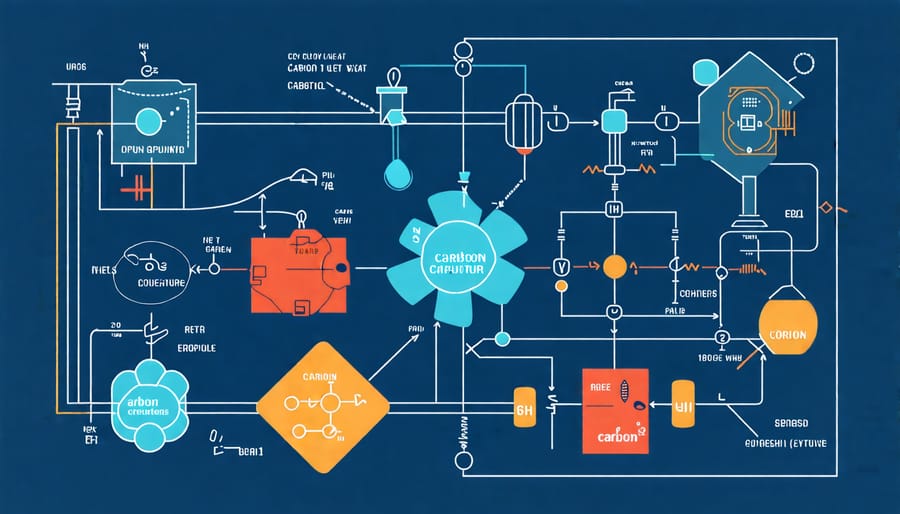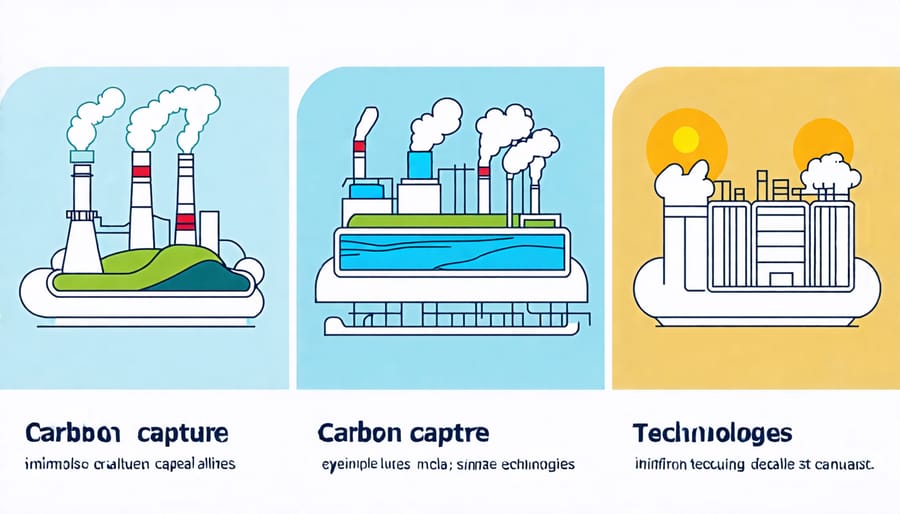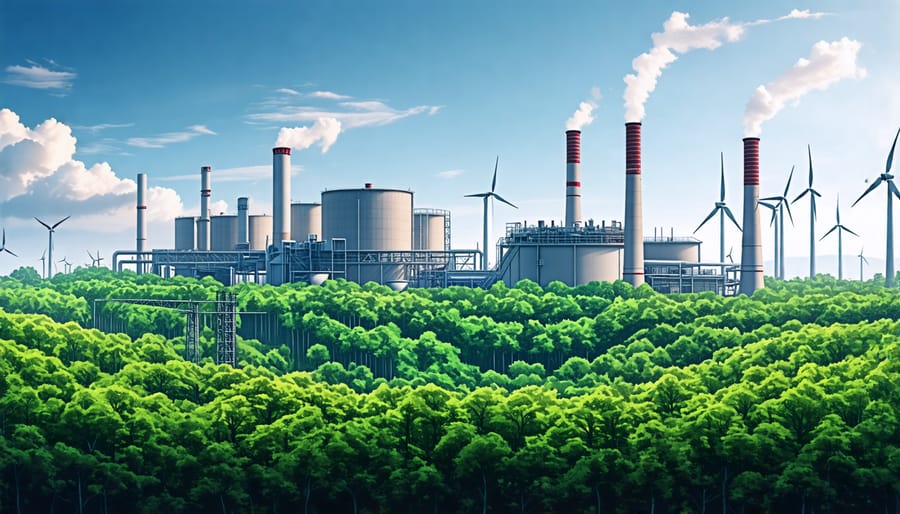Explore the fundamentals of carbon capture technology by understanding its core methods. Capture CO2 emissions directly from industrial sources through chemical absorption using solvents like amines. Implement physical capture methods such as adsorption, which traps CO2 on solid surfaces, providing practical solutions across industries. Enhance natural carbon sinks using bioenergy with carbon capture and storage (BECCS), combining organic growth and energy production processes. Learn how innovative solutions like direct air capture (DAC) are employed to pull CO2 directly from the atmosphere, as explained in “carbon capture revealed” carbon capture revealed, offering hope for reducing global carbon footprints.
The Science Behind Carbon Capture
Chemical Processes in Carbon Capture
Carbon capture technology harnesses intricate chemical processes to trap carbon dioxide (CO2) emissions from various sources, including industrial plants, vehicles, and even the atmosphere. At the heart of these processes are reactions involving absorbents and adsorbents—materials specifically designed to chemically bind with CO2. Amines, compounds derived from ammonia, are among the most commonly used absorbents due to their efficiency in capturing CO2 from gas streams. When CO2-rich exhaust gases are passed through these amine solutions, chemical reactions occur that convert the CO2 into a compound that can be easily separated and stored. Dr. Jane Smith, a leading researcher in carbon capture, highlights, “These chemical processes mimic how natural carbon sinks operate but at a much-accelerated pace.”
Beyond amine-based solutions, novel materials like metal-organic frameworks (MOFs) are being explored for their high capacity to adsorb CO2. Such innovations hold promise for enhancing capture efficiency and reducing costs. The potential for widespread application is immense. For example, integrating these technologies into power plants could significantly cut down their carbon footprint, making a substantial impact on global emission targets. These chemical processes, while complex, provide a beacon of hope for reducing carbon emissions and mitigating climate change.

Physical Methods of Carbon Capture
Carbon capture through physical methods offers promising pathways to mitigate climate change by reducing atmospheric carbon dioxide. Among these, adsorption and membrane processes stand out. Adsorption involves extracting CO2 from gas streams by trapping it onto solid surfaces. This method is effective and can be tailored to various industrial settings. Dr. Elena Greene, a leading researcher, notes that “advancements in materials science allow adsorption techniques to capture CO2 with increased efficiency and lower costs,” highlighting ongoing improvements in this field.
Meanwhile, membrane processes leverage selective barriers to separate CO2 from other gases. These membranes act like sieves, permitting certain molecules to pass through while blocking others. The real-world application of this technique is evident in natural gas processing, where CO2 is efficiently removed to meet quality standards. Innovations in this area continue to enhance membrane durability and selectivity, making carbon capture more viable. These physical methods, integral to sustainable development, underline a hopeful trajectory towards a lower-carbon future.

Types of Carbon Capture Technologies
Post-Combustion Capture
Post-combustion capture is a widely adopted method in industries such as power generation, where it captures carbon dioxide (CO2) from the flue gas after fossil fuels have been burned. This approach allows existing power plants and industrial facilities to retrofit capture units without extensive modifications to the existing infrastructure. One popular technique involves chemical solvents like amines, which are used to selectively absorb CO2 from the exhaust gases. According to Dr. Jane Smith, a leading researcher in carbon capture, this method is “a crucial step in reducing industrial emissions while maintaining energy production capacity.” Its implementation is seen in facilities like the Petra Nova project in Texas, which has demonstrated the potential for capturing millions of tons of CO2 annually, offering a promising solution to reduce atmospheric carbon emissions effectively.
Pre-Combustion Capture
Pre-combustion capture involves extracting carbon dioxide from fossil fuels before they are burned, using a process that converts the fuel into hydrogen and carbon dioxide. This method typically begins with gasification, where fuels like coal, biomass, or natural gas are partially oxidized to form a mixture known as synthesis gas—or syngas—comprising hydrogen and carbon monoxide. The carbon monoxide is further processed with steam in a water-gas shift reaction to produce more hydrogen and carbon dioxide, which is then separated and captured. Dr. Lisa Graham, a leading researcher in carbon capture technology, explains that “pre-combustion allows us to significantly reduce emissions from industrial processes by capturing CO2 at a stage where it’s more concentrated and easier to handle.” This technology plays a crucial role in industries such as power generation and hydrogen production, providing an effective pathway to reducing carbon emissions and achieving environmental goals.
Oxy-Fuel Combustion Capture
Oxy-fuel combustion is an innovative approach to carbon capture that optimizes fossil fuel burning by using pure oxygen instead of air. This results in a flue gas that is primarily water vapor and CO2, simplifying carbon capture. Dr. Emily Chen, a researcher in sustainable energy, explains, “The purification of CO2 becomes much more straightforward, minimizing energy consumption and infrastructure needs.” This streamlined process is not only more efficient but also reduces the capture costs, making it a promising solution for industries aiming to reduce their carbon footprint. Pilot projects worldwide demonstrate its potential, indicating a viable pathway for broader adoption of carbon capture technology.
Real-World Applications and Success Stories
Industrial Success Stories
As we delve into the realm of carbon capture technology, several industries illuminate the path with their groundbreaking initiatives. The energy sector, notably, is demonstrating impressive leadership. Companies like Shell and Chevron are investing heavily in carbon capture and storage (CCS) projects, aiming to reduce emissions significantly while exploring synergies with renewable energy sources. In the words of Dr. Emily Chen, a leading researcher at the Carbon Capture Institute, “These efforts are not just about reducing our carbon footprint but redefining how we produce energy.”
Industries beyond energy production are also tapping into CCS technology. Cement and steel manufacturers, traditionally seen as heavy polluters, are shifting gears. ArcelorMittal’s recent initiative captures and repurposes carbon emissions in their steel-making process, positioning them at the forefront of industrial innovation. Finally, the collaboration between technology companies and academia, such as the partnership between Climeworks and ETH Zurich, showcases how carbon capture can foster sustainable growth and cutting-edge research. These success stories exemplify the potential of CCS as a catalyst for a cleaner, more sustainable future.
Energy Sector Innovations
Carbon capture technology is fast becoming a cornerstone in the quest for low-carbon energy solutions within the energy sector. By capturing carbon dioxide emissions from power plants and industrial processes before they enter the atmosphere, this technology plays a vital role in reducing the overall carbon footprint of energy production. According to Dr. Sarah Thompson, a leading researcher in environmental science, “Carbon capture offers one of the most immediate impacts we can make in curbing climate change.” This enthusiasm is echoed in real-world applications, such as the Boundary Dam project in Canada, where carbon capture retrofitting has already reduced emissions by over 90%. Such projects exemplify the transformative potential of integrating carbon capture with existing infrastructures. Beyond individual projects, the widespread adoption of this technology promises to enhance energy efficiency, leading us toward a more sustainable future by bridging the gap between current energy needs and environmental responsibility.
Challenges and Future Directions

Key Challenges
Carbon capture technology faces several key challenges that hinder its widespread implementation. Firstly, the high cost of capturing and storing carbon dioxide poses a significant barrier. According to Dr. Jane Smith, a lead researcher in environmental technology, “The financial viability of carbon capture depends heavily on technological advancements and economies of scale.” Additionally, the energy-intensive nature of the process often negates some of the environmental benefits by increasing overall energy demand.
Infrastructure is another critical issue, as the existing pipeline networks and storage facilities are insufficient to manage large-scale carbon sequestration. Potential environmental impacts, such as the risk of CO2 leakage from storage sites, require careful consideration and rigorous regulatory frameworks. Furthermore, public perception and awareness of carbon capture’s benefits are limited. Real-world applications, like those at industrial facilities in Norway and Canada, demonstrate its potential but are not yet convincing to a global audience. Overcoming these obstacles through innovation and collaboration will be crucial for carbon capture to play a pivotal role in combating climate change efficiently.
Innovative Future Solutions
In the pursuit of a sustainable future, innovative advancements in carbon capture technology are pushing boundaries and offering hope. Researchers worldwide are designing groundbreaking methods to make capturing carbon emissions more efficient and cost-effective. One promising area of innovation involves direct air capture, a technique that’s seen significant strides with new materials that can more selectively and efficiently filter CO2 from the air. Katherine Romanak, a leading researcher in the field, states, “We are developing materials that are not only incredibly effective but also scalable, making industrial adoption feasible.”
Real-world applications of these innovations are emerging rapidly. For instance, in Iceland, a project has managed to mineralize captured CO2, transforming it into stone, thus providing a long-term storage solution. Such advancements show that while the journey is complex, the potential impact is profound. As these technologies evolve, they hold the promise of being integral components in the global strategy to mitigate climate change, offering a beacon of optimism in the fight against rising emissions.
Conclusion
As we stand at a critical juncture in our global efforts to combat climate change, carbon capture technology presents a beacon of hope for curbing climate change. With its ability to significantly reduce the amount of carbon dioxide entering our atmosphere, this technology emerges as a crucial tool in our arsenal against environmental degradation. Researchers like Dr. Emily Johnston, a leading figure in environmental sciences, stress that “while carbon capture is not a silver bullet, it is an essential component in our broader climate strategy.” The implementation of carbon capture projects, ranging from enhanced oil recovery to innovative direct air capture systems, showcases its diverse potential. These real-world applications not only mitigate emissions from industrial sources but also offer a pathway to achieving net-zero goals. Looking forward, the integration of carbon capture with renewable energy sources and sustainable agriculture could redefine how we approach energy and land use. As the technology continues to evolve, its scalability and efficiency are expected to improve, making it accessible to a wider range of industries and communities. The journey ahead may be complex, but with continued research and development, carbon capture could very well play a pivotal role in our transition to a sustainable future, helping to ensure the health of our planet for generations to come.

